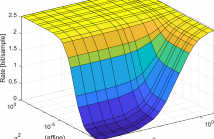
The International Conference on Image Processing (ICIP), sponsored by the IEEE Signal Processing Society, is the premier forum for the presentation of technological advances and research results in the fields of theoretical, experimental, and applied image and video processing. ICIP has been held annually since 1994, brings together leading engineers and scientists in image and video processing from around the world. Visit website.

- Read more about Rate-Distortion Theory for Affine Global Motion Compensation in Video Coding
- Log in to post comments
In this work, we derive the rate-distortion function for video coding using affine global motion compensation.
We model the displacement estimation error during motion estimation and obtain the bit rate after applying the rate-distortion theory.
We assume that the displacement estimation error is caused by a perturbed affine transformation.
The 6 affine transformation parameters are assumed statistically independent, with each of them having a zero-mean Gaussian distributed estimation error.
- Categories:
 14 Views
14 Views
- Read more about A FAST HEURISTIC FOR TILE PARTITIONING AND PROCESSOR ASSIGNMENT IN HEVC
- Log in to post comments
As the compression efficiency of HEVC comes at the cost of high complexity, especially in the encoder’s side, improved parallelization techniques that will speedup the encoding process are essential. One of the parallelization granules offered by HEVC is the tile level, whereby a frame is split into a grid like fashion with each resulting rectangular area (tile) being independently encoded. While tile parallelism has attracted research interest, the primary focus was to characterize performance and develop load balancing schemes assuming a one on one tile processor assignment.
- Categories:
 13 Views
13 Views
Dictionary learning is a popular method for obtaining sparse linear representations for high dimensional data, with many applications in image classification, signal processing and machine learning.
poster.pdf
- Categories:
 7 Views
7 Views
- Read more about RECOGNIZING FINE FACIAL MICRO-EXPRESSIONS USING TWO-DIMENSIONAL LANDMARK FEATURE
- Log in to post comments
- Categories:
 27 Views
27 Views
- Read more about Radial function based ab-initio tomographic reconstruction for cryo electron microscopy
- Log in to post comments
Poster2018.pdf
- Categories:
 6 Views
6 Views
- Read more about Image fusion of X-ray and electron tomograms
- Log in to post comments
ICIP-Yan.pdf
- Categories:
 7 Views
7 Views
- Read more about HIERARCHY OF GANS FOR LEARNING EMBODIED SELF-AWARENESS MODEL
- Log in to post comments
poster.pdf
- Categories:
 13 Views
13 Views
This paper presents three fully convolutional neural network architectures which perform change detection using a pair of coregistered images. Most notably, we propose two Siamese extensions of fully convolutional networks which use heuristics about the current problem to achieve the best results in our tests on two open change detection datasets, using both RGB and multispectral images. We show that our system is able to learn from scratch using annotated change detection images.
- Categories:
 72 Views
72 Views
- Read more about ICIP poster presentation Paper TP.P5.2 (1865): 'SHOT SCALE ANALYSIS IN MOVIES BY CONVOLUTIONAL NEURAL NETWORKS'
- Log in to post comments
The apparent distance of the camera from the subject of a filmed scene, namely shot scale, is one of the prominent formal features of any filmic product, endowed with both stylistic and narrative functions. In this work we propose to use Convolutional Neural Networks for the automatic classification of shot scale into Close-, Medium-, or Long-shots.
- Categories:
 25 Views
25 Views
- Read more about OBJECTNESS-AWARE TRACKING VIA DOUBLE-LAYER MODEL
- Log in to post comments
The prediction drifts to the non-object backgrounds is a critical issue in conversional correlation filter (CF) based trackers. The key insight of this paper is to propose a doublelayer model to address this problem. Specifically, the first layer is a CF tracker, which is employed to predict a rough position of the target, and the objectness layer, which is regarded as the second layer, is utilized to reveal the object characteristics of the predicted target.
- Categories:
 12 Views
12 Views